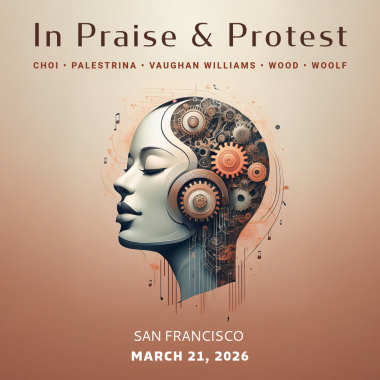
This bold and moving choral program explores sacred beauty, social conscience, and the enduring power of the human voice across five centuries. From luminous evening hymns to searing protest works, the evening offers a journey through music that elevates, interrogates, and ultimately calls us to act.
The program opens with Hail, Gladdening Light by Irish-English composer Charles Wood. Rooted in the Anglican choral tradition, this late-19th-century setting of the ancient Greek hymn Phos Hilaron glows with serene reverence. Scored for double choir, the piece rises from hushed invocation to radiant exultation, capturing both the mystical stillness of dusk and the joy of spiritual illumination. Wood’s harmonic language evokes the cathedral’s echoing vaults and establishes a mood of contemplative grandeur.
This atmosphere prepares the listener for Magnificat à 8 by Giovanni da Palestrina, a masterwork of Renaissance polyphony. Scored for two four-part choirs, Palestrina’s setting of Mary’s song of praise unfolds in noble arcs of imitative counterpoint and graceful interplay. The music’s clarity and balance reflect the composer’s gift for marrying form and devotion—crafting sacred architecture in sound. Its inclusion anchors the program in the sacred traditions of Western music, offering a moment of sublime equilibrium.
Ralph Vaughan Williams’ Mass in G Minor bridges past and present, drawing inspiration from the Renaissance masters while channeling a deeply personal spiritual vision shaped by the trauma of World War I. Composed in 1921, the Mass employs modal harmonies, plainsong-like melodies, and intricate choral textures to create a mystical and introspective work. Scored for double choir and solo quartet, it is at once a homage to the ancient church and a cry for transcendence in the modern world—a spiritual reckoning as much as a sacred offering.
The second half turns toward contemporary works that confront the brokenness of our world with prophetic force. Saunder Choi’s The New Colossus transforms Emma Lazarus’s iconic sonnet—engraved at the base of the Statue of Liberty—into a choral act of protest and lament. As an immigrant himself, Choi sets the text with rich, layered textures and emotional urgency, challenging the myth of welcome in an era of exclusion. The piece becomes a meditation on national identity and moral responsibility, reframing a historic symbol as a site of struggle.
Luna Pearl Woolf’s Après Moi, le Déluge delivers the program’s stark and unforgettable conclusion. From the composer: Après Moi, le Déluge is a concerto for cello and a cappella choir written in the weeks and months after Hurricane Katrina struck New Orleans and the United States’ Gulf Coast in late August 2005. The piece was originally conceived with an entirely different text, but in our grief, rage and shame at the betrayal of the hurricane’s aftermath, the poet Eleanor Wilner and I decided to scrap those plans and begin anew.
A note on the title:
“Après moi, le déluge” are reputed to be the last words of Louis XV, king of France from 1715- 1774 and the heir of Louis XIV, the king for whom Louisiana was named. Louis XIV’s legacy to Louis XV was a nation bankrupted by war and imperial ambition, a debt levied on the peas- antry while the nobility lived tax-free. Louis XV ruled ineffectively, lived luxuriously, and died the most unpopular king in French history. “The words ‘après moi le déluge’,” according to Paul Jay of Independent World Television News, “have come to epitomize the psychology of those who ruin people and the earth with no thought for tomorrow.” Après Moi, le Déluge was commissioned by cellist Matt Haimovitz as part of his “Buck the Concerto” series of commissions for cello and unusual ensembles. It was premiered in 2006 by Haimovitz and the University of Wisconsin, Madison, Concert Choir, under the direction of Beverly Taylor, and recorded live for Oxingale Records. Matt and the choir later took Après Moi, le Déluge on tour, performing in New Orleans November 2006. Après Moi, le Déluge also forms half of a fine-press book entitled Waterlines, with woodcuts and etchings by Michael Kuch, from Oxingale Press and Double Elephant Press.
